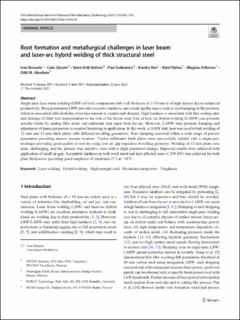| dc.contributor.author | Bunaziv, Ivan | |
| dc.contributor.author | Dørum, Cato | |
| dc.contributor.author | Nielsen, Steen Erik | |
| dc.contributor.author | Suikkanen, Pasi | |
| dc.contributor.author | Ren, Xiaobo | |
| dc.contributor.author | Nyhus, Bård | |
| dc.contributor.author | Eriksson, Magnus Carl Fredrik | |
| dc.contributor.author | Akselsen, Odd Magne | |
| dc.date.accessioned | 2022-09-05T06:27:27Z | |
| dc.date.available | 2022-09-05T06:27:27Z | |
| dc.date.created | 2021-08-17T12:59:19Z | |
| dc.date.issued | 2021 | |
| dc.identifier.citation | The International Journal of Advanced Manufacturing Technology. 2021, 116 561-578. | en_US |
| dc.identifier.issn | 0268-3768 | |
| dc.identifier.uri | https://hdl.handle.net/11250/3015620 | |
| dc.description.abstract | Single-pass laser beam welding (LBW) of steel components with wall thickness of > 10 mm is of high interest due to enhanced productivity. Deep penetration LBW provides excessive hardness and certain quality issues such as root humping in flat position, which is associated with disability of surface tension to sustain melt dropout. High hardness is associated with fast cooling rates and shortage of filler wire transportation to the root of the fusion zone. Use of laser-arc hybrid welding (LAHW) can promote acicular ferrite by adding filler metal and additional heat input from the arc. However, LAHW may promote humping and adjustment of many parameters is required hindering its application. In this work, a 16 kW disk laser was used in butt welding of 12 mm and 15 mm thick plates with different bevelling geometries. Root humping occurred within a wide range of process parameters providing narrow process window. Twelve millimeter thick plates were successfully welded with a single-pass technique providing good quality of root by using zero air gap regardless bevelling geometry. Welding of 15 mm plates was more challenging, and the process was sensitive even with a slight parameter change. Improved results were achieved with application of small air gap. Acceptable hardness in both weld metal and heat affected zone (< 290 HV) was achieved for both plate thicknesses providing good toughness of minimum 27 J at −50°C. | en_US |
| dc.language.iso | eng | en_US |
| dc.publisher | Springer | en_US |
| dc.rights | Navngivelse 4.0 Internasjonal | * |
| dc.rights.uri | http://creativecommons.org/licenses/by/4.0/deed.no | * |
| dc.title | Root formation and metallurgical challenges in laser beam and laser-arc hybrid welding of thick structural steel | en_US |
| dc.type | Peer reviewed | en_US |
| dc.type | Journal article | en_US |
| dc.description.version | publishedVersion | en_US |
| dc.rights.holder | Copyright: The Author(s) 2021 | en_US |
| dc.source.pagenumber | 561-578 | en_US |
| dc.source.volume | 116 | en_US |
| dc.source.journal | The International Journal of Advanced Manufacturing Technology | en_US |
| dc.identifier.doi | 10.1007/s00170-021-07453-0 | |
| dc.identifier.cristin | 1926619 | |
| cristin.ispublished | true | |
| cristin.fulltext | original | |
| cristin.qualitycode | 2 | |

